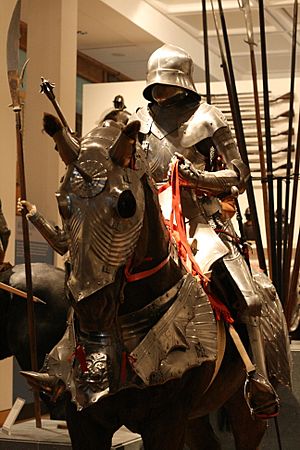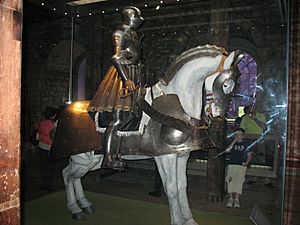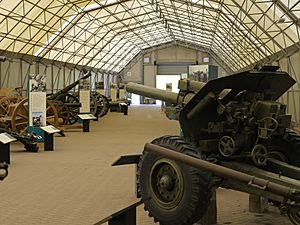Royal Armouries facts for kids
 |
|
| Non-departmental public body overview | |
|---|---|
| Formed | 1983 (43 years ago) |
| Jurisdiction | United Kingdom |
| Headquarters | Leeds |
| Non-departmental public body executives |
|
| Parent department | Department for Culture, Media and Sport |


The Royal Armouries is like a super cool treasure chest for the United Kingdom! It holds the country's national collection of weapons and armour. Imagine suits of armour, swords, and cannons – all in one place!
This amazing collection started a long, long time ago as an important part of England's army. It's now the oldest museum in the UK, and one of the oldest in the whole world. It's also one of the biggest collections of weapons and armour anywhere! It includes the UK's National Collection of Arms and Armour, the National Artillery Collection, and the National Firearms Collection.
The collection was first kept in the Tower of London way back in the 1400s. Today, you can see these incredible items at three different places: the Tower of London, the Royal Armouries Museum in Leeds, and Fort Nelson near Portsmouth. For a while, from 2004 to 2015, some items were even shown in Louisville, Kentucky, in the United States!
Contents
History of the Royal Armouries
The Royal Armouries has a really long and interesting history. It began as part of the Tower of London and used to make armour for the Kings of England and their soldiers.
How the Armoury Started
Around the mid-1400s, a special department called the King's Privy Wardrobe at the Tower of London grew into the Office of the Armoury. From 1423, the Master of the King's Armour was in charge. This office, located in the White Tower, made armour and sharp weapons for the king and his armies. It worked alongside another office, the Office of Ordnance, which handled firearms.
The Armoury had workshops and storage places in towns like Woolwich and Portsmouth. It also had special workshops at royal palaces, like the Greenwich Armoury, which was famous for making fancy, decorated ceremonial armour.
Becoming a Museum
People started visiting the Armoury to see its collection as early as 1545. By the time King Charles II was on the throne, there was a permanent public display. This included the "Spanish Armoury" with some old torture tools and the "Line of Kings," which was a row of wooden statues dressed as English kings. This display makes the Royal Armouries the very first museum in Britain!

As time went on, firearms became more common in wars, and traditional weapons like swords and armour were used less. By the 1620s, the Office of Ordnance was mostly in charge of giving out weapons. The Armoury kept going until 1671, when it became part of the Ordnance Board. This board continued to look after the Armoury and even made it a bigger museum.
The Tower of London was involved in making and storing many types of weapons until 1855. After that, the amazing historic collection stayed. However, only a small part of it could be shown to the public. So, in 1995, much of the artillery collection moved to Fort Nelson in Hampshire. The next year, a brand new Royal Armouries Museum opened in Leeds. The part of the collection still at the Tower of London is directly connected to its history.
In 1983, a law called the National Heritage Act 1983 officially made the Armouries a special public body. It is now supported by the Department for Culture, Media and Sport.
Master of the Armouries Role
The person in charge of the Royal Armouries is called the Master of the Armouries. This is a very old job title that was brought back in 1935 when the Royal Armouries became a national museum.
Past Masters of the Armoury
The Master of the Armoury used to be responsible for keeping a supply of armour and weapons ready for war. This person had an office in the Tower of London. The title was first used in 1462. Many important people held this role over the centuries, including Sir Richard Guildford and Sir John Dudley. The office was eventually stopped in 1671.
Modern Masters of the Armouries
When the role was brought back in 1935, Charles John Ffoulkes became the first modern Master. Other notable Masters included Sir James Mann and Alexander Vesey Bethune Norman. Today, the Director General and Master of the Armouries is Nat Edwards, who started in 2022.
See also
 In Spanish: Royal Armouries para niños
In Spanish: Royal Armouries para niños


